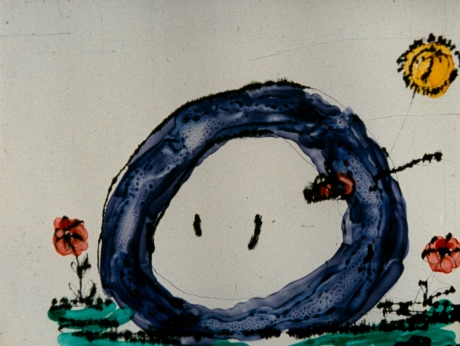
 overview
overview

 storyline
storyline
A disturbingly edited expressive collage, which explores the theme of the passing of time, comprises of several motives known to be often employed by Julian Józef Antonisz in his non-camera work (‘The Disaster’, ‘Old Man’s Blues Non Camera, or Feet First’, ‘What Do We See Upon Closing Our Eyes and Covering Our Ears. A Non-Camera Film’): the Sun, a beating heart, twisted human bodies, withered leaves, chimneys smoking over an industrial site. The world decomposes and deconstructs itself as the seasons change. Its colors fade, the world turns black and white. The screen is gradually obscured by a thick black smoke. Everything is fading, disintegrating, falling apart - the trees, the flowers, the people... The people wither like leaves.

 comment
comment



















Up until the year 1977 Julian Józef Antonisz had taken up various animation techniques (including drawings, paper-cuts or even puppets) to produce pieces which would be later juxtaposed with non-animated (live action) shots so as to create various collages. By 1977, the year ‘The Sun - A Non-Camera Film’ was produced, the non-camera filmmaking technique had become the artist’s only focus, while his experiments began to exceed the edges of the visual field and explored also sound.
One of the boards included in ‘People Wither Like Leaves... A Non-Camera Film’ reads: "The music featured in the movie has been drawn by using graphical methods directly onto the film". He managed to compose the soundtrack using graphic signs modeling streams of light. The resulting ‘scratched’ sound can also be heard in ‘What Do We See Upon Closing Our Eyes and Covering Our Ears. A Non-Camera Film’ (1978). In 1966, even before his directorial debut (‘The Phobia’, 1967) the Cracow artist had written in his Non-Camera Animation Museums' Experimental Animation Studio's Artistic Manifesto what follows: ’The technique of the manual mapping of graphic signs onto a film, being the most direct one, poses the perfect epitome of a method in which the sounds are being synthesized without over-relying on electronic equipment. Drawing sound on tape is now simple due to Julian Józef Antonisz's ’grapophone’. Graphophonography is a chance that has so far not been taken by composers."
These explorations in non-camera sound resulted in some interesting effects (Antonisz himself claimed to even have "scratched" the sound of his own daughters' names - Sabina and Malwina) which did, however, outshine the overall appeal of the visual outcome. Suffice it to compare his early non-camera endeavours with the later, award-winning (e.g. in Cracow and Oberhausen) ones, be it ‘Old Man’s Blues Non-Camera, or Feet First’ (1978), or the non-camera version of the first book of ‘Sir Thaddeus’ by Adam Mickiewicz (1980). Antonisz always considered the non-camera technique as a means to a more significant end. What we now have is no longer a child's game and experiment, but the real art of cinema seeking means to deliver a meaningful and often complex substance. It is also worth mentioning that all of the machinery used by Antonisz in the process of his non-camera film-making had been engineered by the artist himself. Jerzy Armata